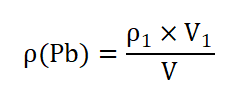- Methodenprinzip
Nach entsprechender Vorbehandlung wird die Probe in einen Graphitrohrzerstäuber injiziert. Die Blei-Ionen werden bei hohen Temperaturen im Graphitrohr in Atomdampf dissoziiert. Die Grundzustandsatome des Zielelements absorbieren die von einer Bleihohlkathodenlampe emittierte Resonanzlinie, und die Absorptionsintensität ist innerhalb eines bestimmten Bereichs proportional zur Bleikonzentration, was eine quantitative Analyse des Bleigehalts ermöglicht.
- Instrumente und Reagenzien
- Instrumente und Ausrüstung
- Detektionsinstrumente:
- Temperaturgeregelte elektrische Heizplatte (Raumtemperatur-300°C)
- 10-mL-Kolorimetrie-Röhrchen
- Mikropipetten (20μL-200μL, 100μL-1000μL, 1000μL-5000μL)
- 100 mL und 1000 mL Messkolben
- Vorbehandlungsgeräte: Wie Detektionsgeräte, für den Probenaufschluss und die Lösungsvorbereitung.
- Reagenzien
- Wichtige Reagenzien:
- Salpetersäure in MOS-Qualität.
- 1+99 Salpetersäurelösung: 10 mL Salpetersäure werden in einen 1000-mL-Messkolben mit einer kleinen Menge Wasser gegeben und bis zur Marke mit Wasser verdünnt.
- Standardlösungen:
- Stammlösung: GBW(E)082818-2 Bleistandard-Stammlösung, 1000 μg/mL.
- Zwischenlösung: 100 μg/mL (hergestellt durch Verdünnen von 10,0 mL Stammlösung auf 100 mL mit 1+99 Salpetersäure; stabil für 1 Woche).
- Arbeitslösung: 1,0 μg/mL (hergestellt durch Verdünnen von 1,0 mL der Zwischenlösung auf 100 mL mit 1+99 Salpetersäure; vor Gebrauch frisch hergestellt).
- Standardreihen: 0,00, 2,50, 5,00, 10,00, 20,00, 30,00, 40,00 μg/L (hergestellt durch Verdünnung der Arbeitslösung).
III.
- Probenvorbereitung
- Vorbehandlung:
- Klare Wasserproben können direkt gemessen werden.
- Proben mit einem hohen Anteil an Schwebstoffen müssen angesäuert und die organischen Stoffe aufgeschlossen werden (die einzelnen Aufschlussschritte werden nicht näher erläutert).
- Vorbereitung der Standardlösung: Die Stammlösung wird schrittweise verdünnt, um Zwischen-, Arbeits- und Standardreihenlösungen herzustellen, die alle mit 1+99 Salpetersäure aufgefüllt werden.
- Probentests
- Testbedingungen:
- Spektrale Parameter:
- Wellenlänge: 283,3 nm
- Spektrale Bandbreite: 0,4 nm
- Strom der Elementlampe: 3,0 mA
- Hintergrundkorrektur: Deuterium-Lampe
- Injektionsvolumen: 15 μL
- Heizprogramm für Graphitöfen:
- Trocknen: 110°C, 10 s Hochfahren, 10 s Halten, hoher interner Gasfluss.
- Veraschung: 350°C, 10 s Hochfahren, 10 s Halten, hoher interner Gasfluss.
- Zerstäubung: 1700°C, 0 s Hochfahren, 3 s Halten, interner Gasstrom aus.
- Reinigung: 1900°C, 1 s Hochfahren, 2 s Halten, hoher interner Gasfluss.
- Schritte der Messung: Injizieren Sie Reagenzleerwert, Standardreihe und Proben in das Graphitrohr, um die Absorption zu messen. Subtrahieren Sie die Leerwert-Extinktion von der Extinktion jeder Standardlösung, stellen Sie eine Arbeitskurve mit der Extinktion (Ordinate) gegen die Bleikonzentration (Abszisse) auf und bestimmen Sie die Bleikonzentration der Probe anhand der Kurve.
- Ergebnisberechnung
Wo:
-ρ(Pb): Bleikonzentration in der Wasserprobe (μg/L);
-ρ1: Aus der Kalibrierkurve ermittelte Bleikonzentration der Probe (μg/L);
-V1 : Volumen der untersuchten Probe (mL);
- V: Volumen der ursprünglichen Wasserprobe (mL).
- Methodische Parameter
- Minimale nachweisbare Massekonzentration
- Nachweisgrenze: Berechnet aus 11 Leerwertmessungen. Standardabweichung S0 = 0,00044, Kalibrierkurvengleichung A = 0,0060C + 0,0013, Korrelationskoeffizient 0,99915. Nachweisgrenze: 0,22μg/L; minimale nachweisbare Massenkonzentration: 0.88μg/L.
- Präzision
- Ergebnisse der Überprüfung: Sieben wiederholte Messungen derselben Probe ergaben eine durchschnittliche Absorption von 0,1509, eine Standardabweichung von 0,0046 und eine relative Standardabweichung (RSD) von 3,0%, was den Präzisionsanforderungen entspricht.
- Genauigkeit
- Standard-Probentests:
- Probe 201237 (Standardwert: 42,0 ng/mL): Durchschnittlicher Messwert 42,425 ng/ml, innerhalb der erweiterten Unsicherheit (3,1 ng/ml).
- Probe 201236 (Standardwert: 152,0 ng/ml): Durchschnittlicher Messwert 147,85 ng/ml, innerhalb der erweiterten Unsicherheit (12 ng/ml).
- Tatsächliche Probenmessung
- Parallele Messungen von drei Oberflächenwasserproben ergaben relative Fehler von 3,62%-4,31%, was den Anforderungen an die Parallelität entspricht.
- Vorsichtsmaßnahmen
- Wasserproben mit einem hohen Anteil an Schwebstoffen vorbehandeln, um organische Störungen zu beseitigen.
- Bereiten Sie Standardlösungen durch stufenweise Verdünnung vor, um die Konzentrationsgenauigkeit zu gewährleisten.
- Kontrollieren Sie das Heizprogramm des Graphitofens genau, um Hintergrundstörungen und unvollständige Zerstäubung zu vermeiden.






